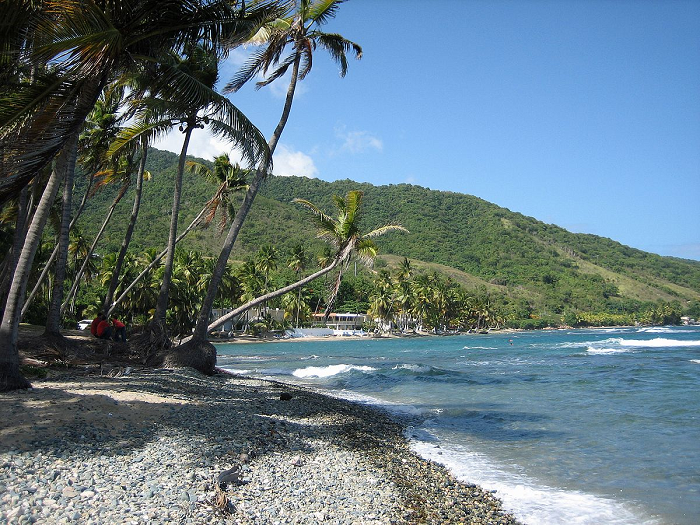
TRANSLATOR’S NOTE: The following is an account of the events surrounding an alleged apparition of Our Blessed Mother in Puerto Rico. Should these events be approved by the Church as worthy of belief, that would be the only continuous apparition of Our Lady ever, lasting from 1899 until 1909, beginning shortly after the end of the Spanish American War of 1898. The events described below took place in an isolated mountainous area in Puerto Rico at a time when communications to and from the island were few. Carlos Caso-Rosendi
Please remember to pray for (and if possible donate to) this ministry during Lent season.
The Holy Mountain (Santa Montaña), altitude: 2,226 ft above sea level, in the Espino neighborhood of the Municipality of San Lorenzo, is a locality near where the municipalities of San Lorenzo, Patillas and Cayey meet. This mountainous region is located within a natural reserve—the Carite Forest—which consists of about 6,400 acres of tropical rain forest that are part of the Sierra of Cayey. As of 1954 and by mandate of the government of Puerto Rico—for all official purposes, including cartography—Cerro Las Peñas (The Stones Hill) was named Cerro de Nuestra Madre (Our Mother’s Hill).
The Our Lady of Mt Carmel Diocesan Sanctuary, is located at the top of La Santa Montaña in Puerto Rico. It was built and dedicated in 1985 by the bishop emeritus of the Diocese of Caguas, Monsignor Enrique Hernández Rivera. The story of La Santa Montaña begins on August 8, 1899, when the atmospheric phenomenon known as Hurricane San Ciriaco left the island after crossing it diagonally leaving 3,369 dead and hundreds of thousands homeless. The losses were estimated by the government at the time in US$35.8 million.

I am Your Blessing: Buenaventura
Around mid-afternoon of August 8, 1899, as Hurricane San Ciriaco was leaving the northwest coast of the island to enter the waters of the Atlantic Ocean, two peasants arrived, machetes in hand, to the Calzada neighborhood of the town of Maunabo to save several cows that were in peril of drowning. The animals were stuck in a small plain adjoining the Maunabo River. The plain where the cattle were stranded was under two feet of water due to the river overflowing. The river waters were held at its mouth by the storm surge that pressed from the southeast corner of Puerto Rico.
There, the two peasants detected a figure that ‘floated,’ apparently standing on a plank on the waters of the Caribbean Sea. They kept their eyes fixed on the ‘plank’ on which both thought the woman was standing. The ‘plank’ continued floating on the sea waters in a westerly direction driven by the current, so the peasants lost sight of it when it passed Cape Mala Pascua, and approached the coast of the Bajo sector of the municipality of Patillas. That area can be described as rocky beaches formed by marine erosion.
Two days later, several residents of the Jacaboa neighborhood, in the municipality of Patillas, saw an unknown girl walking through the area in a northeasterly direction, en route to Carite Forest. The young woman made a stop at the residence of the Poche family to reprimand a clan member for mistreating a cow, explaining in a sweet and gentle voice that: “All creatures of God deserve respect.” The young man she rebuked, returned home trembling. He told his mother: “After saying that, the girl vanished in thin air.” The following week, the beautiful girl was seen by neighbors who lived near Macarena Road, a route connecting the municipalities of Yabucoa and San Lorenzo.
Some time after the hurricane San Ciriaco passed through the island, a gang of six lumberjacks from the San Salvador neighborhood of Caguas, arrived to Cerro Las Peñas after an hour and a half march. They had started walking before dawn and went through various mountain passes until they reached the Gregorio de San Lorenzo gorge, and continued to the northern slope of Cerro Las Peñas, located in the eastern section of the Carite Forest. That is an area abundant in trees of Tabonuco, Jagüilla, Cupey, Ausubo, Mahogany and White Oak. When the sun rose, the lumberjacks had already climbed to the top of the mountain.
Due to the passage of Hurricane San Ciriaco through the island, the leader of the team, Adolfo Ruiz Medina, had chosen to cut timbers on the slopes of that mountain, whose irregularity and depth had saved hundreds of trees from the fury of the winds. At lunchtime, the crew rested near a granite rock about 15 feet high and 25 feet in diameter. They were about to have lunch when they noticed the presence of another person in a cave nearby, so they silently approached the cavern. To their surprise, they discovered a young woman inside who looked intently at them but remained silent. Adolfo was the first to speak.
“¿Who are you, little girl?”
“I am your Blessing.” [Sp. “soy tu Buenaventura”]
“Are you lost?” Asked one of the lumberjacks.
The young woman did not respond and when one of the members of the group tried to grab her, she vanished. The men searched around for her, yelling out what they thought was her name: ‘Blessing.’ [Sp. “Buenaventura”]
A few days later, around lunchtime, Adolfo grabbed a bucket, called for a break, and headed for a stream to fetch water. He descended the southern slope of the hill, going into the thickest part of the forest. A sweet song that resounded throughout the forest stopped him on his tracks. The lumberjack looked in all directions, but did not see anyone.
The song instilled a great peace in his mind. Step by step he approached the place where that loud voice seemed to come from. When he was near the stream, he saw her. It was the same little woman. She was sitting on a rock, dipping her feet in the water. Adolfo stopped again because the young girl’s voice was not the only one he heard. He could also hear hundreds of children in the forest, singing ‘in the language of the priests’ [Latin.]
Paralyzed with amazement, he stared at the ravine and it was at that moment that she looked up and saw him standing in the middle of the grove, holding his bucket. After a brief conversation, the young woman got up and started to move away from that spot. “She did not walk! She floated as if someone was carrying her!” reported Adolfo. He saw her walk without her feet touching the ground.
A luminosity that increased by seconds began to emanate from the young woman until she acquired such brilliance that she blinded Adolfo, who instinctively dropped the bucket and raised his right arm to cover his eyes with the back of his hand. On both occasions when he looked again to see the girl, he was forced to shield his eyes with his hand. When the glare finally disappeared and he was able to open his eyes, he found himself alone in the ravine. A daze seized the lumberjack and his body, trembling from head to foot, lost all strength causing him to fall sitting on the ground.
“Holy Mary! what is this?”
When he mentioned Mary’s name, Adolfo heard a male voice whispering in his ear: “Take the water and go back to your mates!” The woodcutter looked around trying to find the person who uttered the order, but there was no one around! Obeying, he got up, picked up the bucket, walked to the edge of the ravine, and after filling his bucket to the rim, he returned to the place where his teammates were resting.
A few days after that encounter, the lumberjacks were up on ladders sawing the tall branches of several trees, when they saw the same young woman they had seen by the cave, this time she was floating high above them.
She greeted them: “My children, good morning! Peace be with you! ”
Instantly, the men lowered their sight, not daring to look at her.
“Look at me! do not fear. It is me!”
“Mother, where were you?” “What have you done?” “Forgive me, forgive me!” The woodcutters said, who still did not dare to look upon the girl.
“I was in my house with my beloved Son.”
Little by little, the six men looked up, and when they discovered that the girl was still at high altitude, floating among the branches of a nearby tree, fear overtook them.
“Mother, be careful! You may fall!” They said in unison.
“Build a hut for me here,” she said smiling.
The men looked at each other in amazement. To do what she asked for, required a source nearby providing enough water for all the work involved in the construction of a home. Finally, one of them dared to ask:
“Build a hut here, Mother? There is no water around here! ”
“I want my hut here. Do not worry about the rest.”
The next morning the men transported construction tools to the hill, weeding the plot of land selected by the mysterious visitor to build her humble abode. Shortly before noon, the young woman reappeared before the group.
“My house will stand here, which is for all my children, you first of all.”
“Yes, Mother, we know; your hut will be built here, but the water is very far, “answered one of the men.
“Go there and bring water! Wash and take water to drink!” ordered the young woman.
“Mother, this is a dry place. There’s no water! There are only dry stones!” said Adolfo.
“Go! get the water!” Replied the young woman.
“¡Hurry up to do what Mother says!,” ordered Adolfo.
The group started to march towards an area in the northern part of the peak, where a rock protruded among smaller stones. To their amazement, upon reaching the rock formation, they discovered a spring of crystalline water gushing forth from the formerly dry spot.
During the next four days they worked nonstop building the house, sawing trees, cutting hooks, shelling out logs, preparing boards, carving poles and beams and placing everything in its place. The final product consisted of a small rectangular dwelling about 12 ft wide by 16 ft long and an approximate height of 10 ft, with a porch in front and a gabled roof of palm leaves that extended to cover the porch. Mounted in pillars of hard wood, the house was raised about 3 ft from the ground, so the men made a staircase with three steps that allowed access to the porch.
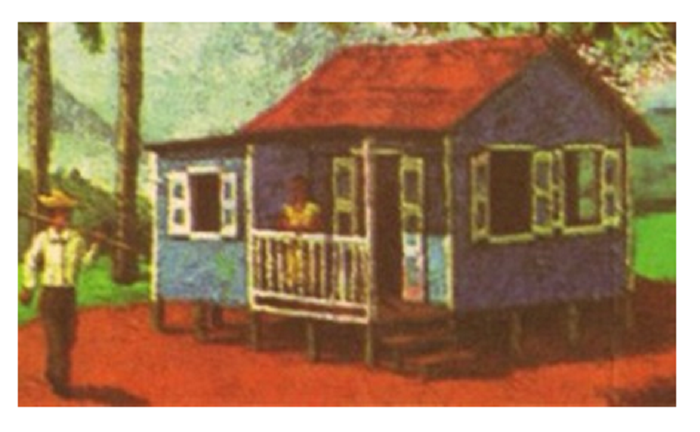
Once the house was completed, the men arrived at the mountain with their usual tools to continue the work interrupted by the construction of the hut. The young woman was waiting for them. From her flowed a great radiance that for a moment left the lumberjacks dumbfounded. So much was their joy to see her that all at once exclaimed: “Mother, Mother good morning!”
“Peace be with you, my little children.”
“Mother, we’ve finished your hut and we’re off to work now,” the squad leader announced.
“We are going to pray before we start to work. Did you do it already?
“No, we have not, but we will do it before we start,” Adolfo replied.
The young woman remained silent and motionless before them, so the workers, one by one, removed their hats and knelt on the ground.
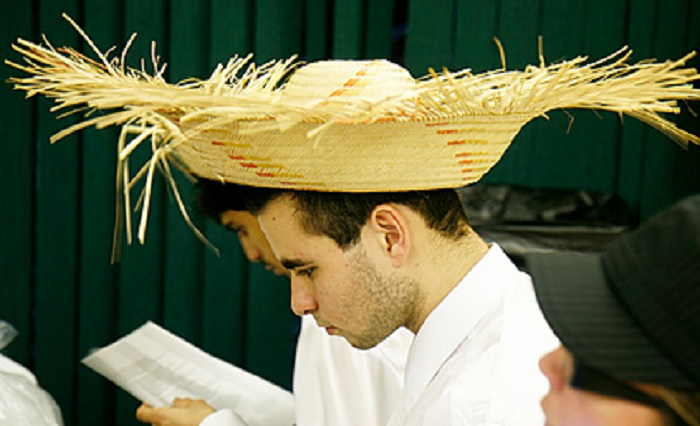
“Repeat after me, little children:
Oh God! I thank you for taking care of me during the night.
Oh God! I thank you for taking care of my mind so I don’t think bad things during the day.
Oh God! I thank you because my eyes don’t look or want anything forbidden.
Oh God! I thank you for my mouth; may I not utter one ugly word.
Oh God! I thank you for I don’t hold a grudge against my neighbor, who is my brother.”
At the conclusion of the prayer, the men bowed their heads and made the sign of the cross.
Mother then said: “¡Go to work, my children!”
They spent the day cutting wood, vines and palms. At the end of the afternoon they returned to the hut to meet with Mother to give thanks for the working day. Then they went back home. En route to San Salvador they stopped by the homes along the road to announce that: “Mother is in her hut to teach the Christian doctrine to everyone.”
Pilgrims began to climb the Cerro Las Peñas, some with their families, to see Mother and listen to her talks. Thus began what Adolfo described as: “Meetings in a holy place, because from the first day she appeared as a child, she blessed all of that mountain.”
The preaching
The news of the arrival of Mother to San Lorenzo ran like wildfire through the coffee plantations of the southeast of the island. Shortly after her house was built, dozens of peasants from nearby places approached. Others crossed great distances to reach the summit of the mount. Crowds came to listen to her preaching from the porch of her humble wooden house. Just before addressing those present—whose number often exceeded a hundred—Mother requested that an image of Our Lady of Mount Carmel was placed on the porch of the house. Along with it she placed a flag, a blue cloth with flaming golden stars, very similar in color and ornaments to the mantle of Our Lady of Guadalupe.
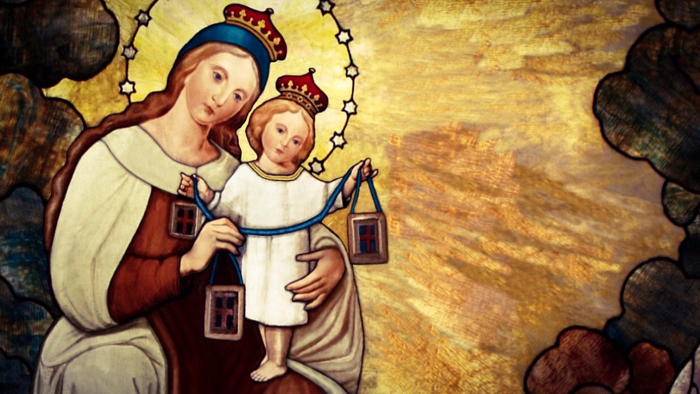
Her sermons, which usually occurred on Wednesdays and Fridays at about six in the afternoon, were announced by blowing a seashell, or an ox horn, to call those who had just finished their daily chores. They were called to the top of the mountain in that manner so they could hear her teaching.
The preaching of Our Mother—spoken in a highly respectful tone to those present, and in simple language, filled with Puerto Rican expressions—revolved around the Gospels, which she referenced with great accuracy. She also detailed the way in which the Gospels were to be applied to daily life. Then she emphasized the importance of: dedicating children to God, of praying first to God, then to the Virgin Mary and the saints. She encouraged the constant recitation of the Rosary, avoiding sin, helping each other, giving to the needy, treating each other as brothers, and for the family to gather together to eat and thus stay together. Many times she reviewed before the crowd the principles of the Catechism, preparing those who had not yet received the Sacraments.
Reception of the Sacraments
There were many occasions in which Our Mother led pilgrimages to the churches of neighboring towns so that the catechumens would be baptized and the couples living together would receive the Sacrament of Marriage.
The farm
Our Mother established a self-sustaining charitable consortium at the top of Cerro Las Peñas, which all the inhabitants of San Lorenzo and neighboring towns referred to as ‘La Santa Montaña’, the Holy Mountain. There she not only preached, but performed miracles, took care of the children’s education, offered help to the needy, and taught the disciples to challenge the colonial economic system to which they were subject by combining efforts and selling handicrafts, mostly baskets.
She also organized the planting and seeding time, giving instructions to her disciples—those who formed her intimate circle of relatives—about when, what and where they should plant. Then they used the produce to feed the hundreds of people who attended her preaching, and to distribute food among the hungry peasants. Her disciples built a chapel About 10 feet from the hut of Our Mother. Important visitors were received in a small house next to it, usually priests and landowners.
A hut was also built for the sewing work. A huge trunk was placed there to store the finished clothes. The tasks of sewing, cooking and cleaning, caring for and feeding of animals, the planting of food, the making of baskets and hammocks, washing clothes, felling trees, construction and maintenance of the structures, as well as guarding the San Lorenzo farm, were all carried out by the disciples residing in the Holy Mountain.
The center of the farm was the hut of Our Mother, where only the members of the group known as ‘The Girls of Our Mother’ could enter. They also belonged to Mother’s inner circle. These girls, whose ages fluctuated between six and twenty years of age and who came from nearby towns, stayed on the mountain for two, three, or four weeks at a time. While they were by her side, Our Mother taught them catechism, prayers, sewing, and other housework, manners, good habits, to be good daughters and wives, how to treat other people, how not to be abusive, reading and writing, and the basic concepts of arithmetic.
The compound was supported by the collection of alms during the sermons and the alms collected by messengers who traveled the neighborhoods near the mountain requesting donations in cash, food, and clothing. The gifts were used to pay the stipends of the Sacraments, and to help the needy.
The missions
Sometimes Our Mother left the San Lorenzo complex on what the disciples called a ‘mission’ (going to preach to other places). The disciples took turns to carry Our Mother sitting in a hammock. On the few occasions when she left the farm on horseback, they were in charge of driving the horse until they reached their destination. These trips were cross-mountain, on narrow and sometimes muddy roads.
Our Mother usually preached for four hours or longer in the places she visited. Her presence always instilled respect and fear of God. More and more people came to receive instruction on the word of God, to be prepared to receive the Sacraments, or to be healed of various ailments. It was enough for someone to feel sick, or in pain, so that Mother would place her hands on the affected part and be healed immediately.
The names
Every time they asked her who she was, she answered “I am your Mother”. She called all those who approached her “children” without exception. Many called her “Our Mother” or simply “Mother.” Many referred to her as the Virgin Mary.
She used the names Elenita de Jesús, Mother Elena, Mamita Elena, and Mother Elenita. [Elena is the Spanish form of the Greek name Helene: derived from the root ēlē (light, torch, bright) Elenita is the diminutive of Elena. “Elenita de Jesús” could be translated as “Little Light of Jesus”].
On February 2, 1985, by means of an affidavit made before the attorney Felificado Pérez de la Torre—a local lawyer and State-certified notary public—Don Bernardo del Valle, one of the disciples of Our Lady of San Lorenzo, said that it was during a sermon in Caguas that she asked to be called Elenita de Jesús. Del Valle served as guardian of her house in the self-sufficient compound founded by Our Mother in La Santa Montaña. There were also people who referred to Our Mother as “La Santa” and many referred to her as the Virgin Mary. The only name Our Mother did not give herself was that of ‘misionera.’

Her powers
During her stay in Puerto Rico, Our Mother showed her power over movement, time, elements, nature, sickness, sun, sound, matter, gravity, and malignancies in the presence of her disciples, priests and the crowds who attended her sermons.
Among the prodigies performed by Our Mother are: multiplication of food, turning the taste of extremely sour fruits into ones of great sweetness, and transmuting herself several times into a dove. She also proved to have advanced knowledge, and unusual control over the laws of physics. She appeared and disappeared among people as a ray of light, made herself invisible only to some selected people three times, stopped the movement of the sun, separated the waters of overflowing rivers to cross from one riverbank to the other. She levitated in countless occasions, and could exercise control over the fauna.
Her preaching began at dusk, which is the moment when some local miniature frogs begin their song. To achieve the greatest possible silence, Our Mother ordered those tiny frogs to be silent and they immediately obeyed her! The birds also stopped their song when she ordered them to do so. That way her voice could be heard throughout the mountain. Eyewitnesses reported her equally amazing knowledge of people’s names. She could address by name those listening to her, even if they had not visited previously. She also was aware of the thoughts and actions of those around her.
The disappearances of Our Mother were also common. Once, she vanished while everyone believed she was in her house. At first her followers were confused. They went searching for her everywhere, even deep in the forest. To everyone’s surprise, she later reappeared in a house at a great distance from the San Lorenzo farm.
The balm
As years went by, the spring that Our Mother made appear among the stones was sold out. The disciples who lived in the farm implored her to intercede to bring up another spring. Our Mother again caused water to surge between the stones, this time on the western slope of the mountain. She called that water “a balm for all my children.” She also promised that the spring would never dry up.
The seclusions
On certain occasions Our Mother apologized to her disciples during the great festivities of the Catholic Church, explaining that she had to go to Heaven for those occasions and then she was secluded in her hut for three days. Her disciples referred to these seclusions as ‘encierros’. On the nights when those occurred, a huge glow shined forth from her hut. That light could be seen at a great distance. In the meanwhile, her faithful guardians did not allow anyone to approach the humble little house.
The music
Our Mother exalted the Puerto Rican culture with her predilection for creole Christmas carols and playing indigenous instruments (güiro, cuatro, and tiple) at Christmas and during other religious festivities while exclaiming aloud: “Viva Puerto Rico!”
She recruited a small group of musicians who played the flute, the accordion, percussion and string instruments to accompany those who sang during the praying of the Rosary and to provide typical Puerto Rican music during special celebrations.
Our Mother’s love for music led her to give a harmonica to a disciple who proved to have musical abilities. While visiting the Piedra Blanca neighborhood of the municipality of Yabucoa, she revealed that “there is singing in Heaven.”
Identity
In time, Our Mother revealed her identity to her Puerto Rican children. On the occasions when she was asked who she was, she affirmed: “I witnessed the death of Jesus”, “I am the mother of all men”, “I am the Mistress of all peoples”, “I am the one who suffered a lot when Jesus died on the cross”, and “I am the Queen of Heaven and Earth.”
She also assured her disciples that she would always remain in Santa Montaña even if only some could see her, while others would only feel her presence there. She promised she would appear before many of them in the form of a dove, or the bird that everyone knew was her favorite (the Puerto Rican zumbador) and that they would recognize her next to Jesus Christ in the Final Judgment.

The first time Our Mother manifested herself as Our Lady of Mount Carmel was when she interrupted one of her sermons in La Santa Montaña. A listener—the cousin of disciple Juan Avelino Martínez—commented: “Elenita looks like a Dutch woman when she preaches”. Mother asked him to stare at her face to determine her true identity. In doing so, the man fell to his knees and identified her in front of everyone as Our Lady of Mount Carmel, insisting that she had seen her crown and the radiance coming out of it.

During a sermon in the Alto Sotero Lebrón sector of the Montones neighborhood, in the municipality of Las Piedras, Our Mother again identified herself in public as Our Lady of Mount Carmel. In time, the pilgrims who came to La Santa Montaña from places outside of San Lorenzo, called her—of their own volition—“Our Lady of Mount Carmel”. At no time did she correct those who called her that way.
About two or three years before leaving Puerto Rico, Our Mother begged her disciples to pray to “Papito Dios”—the name by which she referred to God [a very similar expression to the one used by St Paul in Galatians 4:6]—to allow her to shed her blood in La Santa Montaña “for the forgiveness of all sinners, since this will be a special blessing for Puerto Rico.” Once she began to identify herself as Our Mother Redeemer, she wore a head cover with the initials M and R—separated by a cross (M † R)—engraved on the front area of her hood. Noticing that, some of her disciples referred to her as Redemptive Mother, that is in Spanish, “Madre Redentora.”
A few months before her departure from Puerto Rico, Our Mother sent back home the girls who kept her company in the San Lorenzo farm. One of them, Juana Rodriguez Flores from Caguas, did not want to leave her side and reluctantly walked away weeping. Our Mother called her back. Quickly, Juana returned, but instead of announcing that she could stay, Mother gave her the painting of Our Lady of Mount Carmel that was hanging on the porch. The girl placed the painting against her chest and squeezed it as if it were a gift of immense value. While Juana was leaving the farm again, Our Mother called her to ask if she knew what she was carrying.
“A picture of Our Lady of Mount Carmel,” she responded.
And Our Mother responded: “That is myself. Don’t tell that to anyone.”
The departure
During the year and a half prior to her departure, Our Mother began to prepare her closest disciples so that they could face the final farewell with serenity.
These preparations were announced frequently as “the need to visit other places”. She told them she would not leave in the same way she had arrived in Puerto Rico, “because if I did so, you would all end up in jail.” Our Mother also consoled the disciples regarding her departure by telling them that she would simply ‘change.’
One afternoon Our Mother summoned the disciples in front of her hut and informed them that they would not see her for a long period of time. They all concluded that she was going to go in one of her retreats. However, that was her final departure.
That final confinement, that lasted 40 days, began on Saturday, August 21. During that period of time she only spoke with Francisca Gómez Montes, one of the who were always by her side. Around September 22, Our Mother told Francisca what to do with the blood Mother would shed. Mother instructed the girl about where to place her body and the candlesticks for the wake, which was to last three days. Meanwhile, the ‘disappearance’ of Our Mother had reached the ears of the authorities. The head of the police headquarters in San Lorenzo, responding to reports from local residents about the absence of Our Mother, sent two officers to Santa Montaña to verify that she had not suffered any mishap.
The officers went to the farm. When they found out that Our Mother was not in the vicinity, they threatened the disciples and told them, that if she did not appear within the next three days, they would all be imprisoned. Three days later, when the two guards returned to the farm, Our Mother reappeared among some frightened disciples. After greeting the agents and assuring them that she was unharmed, she sent them back to town. When the policemen left, Our Mother took advantage of the event to emphasize her reasons not to leave in the same way she had arrived in Puerto Rico.
“I already told you that if I leave in that way, all my beloved children would end up in jail.”
Afterwards, she informed them that: “I want to be alone for the next three days to prepare myself. After three days, go [to the hut] and check under my room. You will see blood dripping through the cracks between the floorboards. That will be my blood, that I will pour before I leave. Then you can enter my room. I will not be here anymore, but do not say that I died, but that I was changed. Put me in a box just as you find me, with my Rosary and everything. I will be ready. Then take me to the cemetery in San Lorenzo.”
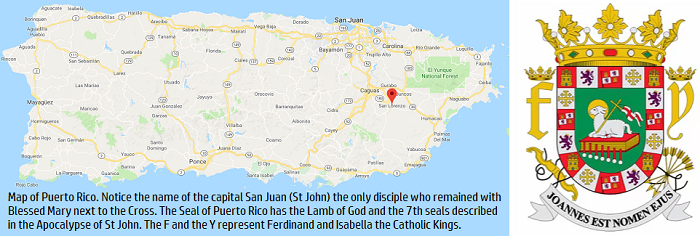
Under the sad watch of the peasants, Our Mother entered her hut to stay there the three remaining days of her last confinement. At times, the disciples heard her play her güiro while singing a couplet that said in part:
“Los niños de pecho lloran,
los pecadores se afligen,
porque nuestra gente dice:
adiós Madre Redentora.”
[Little children cry / sinners grieve / because our people say: / goodbye, Mother Redeemer.]
At dawn on Wednesday, September 29, the day of the feast of St Michael the Archangel —whose name until 1911 was part of the original name of the town of San Lorenzo: San Miguel del Hato Grande—the disciple José González lit a heater to prepare coffee for those keeping a vigil in the mountain. While he was doing that, Gonzalez heard the voice of Our Mother, so he immediately fell to his knees and bowed his head.
“I have already changed, my son, but I will be with you until the last day and I will receive you in the glory of heaven.”
[“Ya he dado el cambio, hijito, pero estaré con ustedes hasta el último día y los recibiré gloriosamente en el cielo.”]
Looking up, Gonzalez noticed that Our Mother was gone. Immediately he gave notice of what happened to the other disciples, so that all hurried and went to Mother’s hut. They saw blood dripping through the cracks of the house floor forming a puddle under the structure. Everyone remembered the words that she had pronounced several times: “Blessed is Puerto Rico if I shed my blood here!”
When they discovered the blood under the hut, the disciples understood they had permission to enter the hut. There they found the body of Our Mother lying on the floor of her room. She was already shrouded with a balm that they described “as lilac.”
Once the spirits were somewhat restored, one of the messengers left the mission in search of Francisca Gómez. Our Mother had taught Francisca how to take care of her body and her blood with the help of the other girls. Meanwhile, other disciples left Santa Montaña in various directions to spread the word about Mother’s change among the residents of nearby neighborhoods, and to notify the San Lorenzo authorities about her departure.
Arriving at the farm, the group of girls headed by Francisca did everything as instructed by Our Mother, picking up her blood with white cloths that were later placed inside several glass jars, which in turn were buried near her hut.
That afternoon, the judge of San Lorenzo, Emilio Buitrago, visited the wake in the mountain. Once he determined that the change of Our Mother had not been caused by any evil act, he concluded: “The body of Mother Elenita now belongs to the angels.”
During the early hours of Friday, October 1st, the girls wrapped her body in a shroud and placed it inside the coffin to be taken to the cemetery of San Lorenzo.
As the funeral procession advanced towards the north, crossing the sectors between Santa Montaña and the settled center of the municipality, the authorities estimated that about 20,000 people joined the procession.
Father Puras, parish priest of the church of San Lorenzo was already wearing his funeral clothes, He went out to join the procession. Stopping by the box, he exclaimed: “¡If you only knew who you are carrying there!” Immediately, the priest fell on his knees, asking forgiveness for the offenses he had committed. Father Pedro Puras was the parish priest of the Church of Our Lady of the Immaculate Conception of the island-municipality of Vieques until June of 1919.
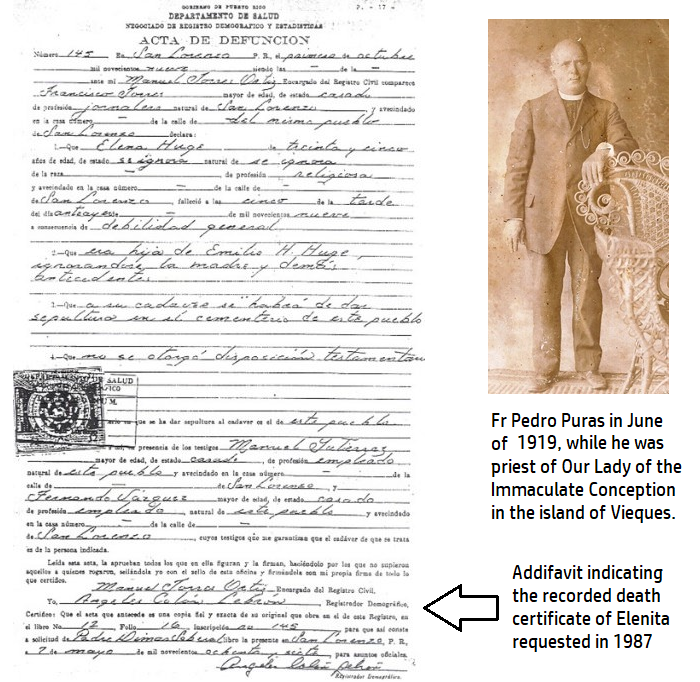
Upon entering the church, the disciples carrying the coffin told the priest that—as they advanced towards San Lorenzo—the weight of the coffin began to diminish. It seemed to be empty when they arrived in town.
To bury the body according to law, it was necessary for the village doctor to sign a death certificate. In the case of Our Mother became a pro forma document, since it was prepared without a medical examination of the body. The information supplied by Francisco Torres was sufficient because the deceased lacked a birth certificate, baptismal certificate, or any other kind of identification.
The act (number 145 in Folio 16 of Book 12 of the municipal registry of deaths) includes the age of the deceased—35 years—attributes the death to general weakness, and notes the cemetery of San Lorenzo as the place of burial. The deceased appears registered under the name of Elena Huge. No one knows why that surname appears in the death certificate, although the theories abound in that regard. Some say that it was suggested by a pro-annexation lawyer—someone in favor of the annexation of Puerto Rico to the United States— Mr Huge, a lawyer working in the Caguas-San Lorenzo area, was determined to eliminate all traces of Elenita de Jesús from the official record.
After the Requiem Mass, the funeral procession continued marching towards its final destination, the crypt of the Sellés Family in the municipal cemetery. Members of that family had agreed to have Our Mother buried there.
Those who carried the box during the last part of the trip were the male disciples of the farm. They looked at each other in complicity because the light weight of the coffin showed that in all probability it was totally empty. The disciples deposited the coffin on the ground in front of the cemetery and solemnly helped the gravedigger bury the box.
The town was still full of people and although the clothes of the disciples were soaked by the poring rain, and they felt extremely tired and hungry after 12 hours of pilgrimage, they still decide to go back to the Holy Mountain. When arriving at the farm, they were dismayed after looking for Mother everywhere and not finding her. Adolfo Ruiz Medina brought a new ray of hope with seven words: “We have not looked in La Santa Peña!” [Holy Rock]
They all hurried down the northern slope of the mountain and when they reached the granite rock, they were stopped in their tracks: standing next to the cliff, all surrounded by light, their Blessing was waiting for them, smiling.
The image
The first thing the disciples of Our Mother did after her ‘change’ was to collect money to pay for the engraving of the words ‘Mother Redeemer’ on her burial stone in the crypt of the Sellés family. Then they planted bush around the place where she was changed in La Santa Montaña, so that no one would step on her grave. Funds were raised also for the construction of a sanctuary. Meanwhile, Fr Puras went up to the farm three times a week to celebrate Mass in the chapel that Our Mother had built.
An image of Our Lady of Mount Carmel arrived later. Our Mother had ordered the image from a workshop in Spain through a resident of San Lorenzo, and the disciples were astonished to see that she had a strong resemblance to Our Mother. That image was taken on solemn procession by some six thousand people to La Santa Montaña, where it remains until today.

Throughout the subsequent decades, pilgrims continued visiting Santa Montaña and in August 1982, two girls both from the municipality of Cidra who frequently visited the place with relatives, Aida Rivera (8 years old) and Migdaly Cintrón (7 years old), allegedly spoke with the Virgin Mary during an apparition. Once off their state of trance, Migdaly informed all those present that a very pretty lady appeared in front of her, took her by the hands and told her not to be afraid, “… because I am the mother of God … the Virgin Mary.”
From that moment on, both Migdaly and the other three children of Cidra became Marian seers—Aida Rivera, eight years old, Jessie Bermúdez, and Marilyn Ruiz, both just seven years old—were taken by their relatives three times per week to La Santa Montaña to continue meeting with the Virgin Mary, who asked them to bring flowers, and to proclaim her messages. She also asked them to gather many children—whom she described as “my main concern”—to visit her in The Holy Mountain, and to urge the people to pray and sing hymns because “God is very close to Earth and we are in the last stage of what is decreed to happen.”

On September 25 a crowd of more than 300 people accompanied Migdaly, Marilyn and Aida in the recitation of the Holy Rosary in the area of Santa Montaña known as The Three Crosses. In that occasion the Virgin Mary placed a Rosary in Marilyn’s hands.
Meanwhile, Aida and Migdaly began to levitate. Those in the audience were shocked, noticing that the girls were at a height of three or four feet above the ground with nothing holding them. Some ran away, others fell to the ground or continued to pray and a few, seeing that the distance between the girls and the ground increased, began to scream.
Justina Sánchez, a resident of Cidra who was among the parishioners praying that night, reported that the levitation occurred at about 1:30 a.m. With the help of Antonio Rolón, Sara Sánchez, and Nelly Martínez, she managed to grab Aida by the legs and lower her, but while trying to grab Migdaly the girl’s body moved horizontally with arms outstretched. Migdaly floated for about five minutes at a height of more than seven feet and after much effort, the same people who managed to get Aida down reached the body of Migdaly and brought her back on the ground.
During the following months, both the children seers and many of the people who visited La Santa Montaña told the media that they had heard a choir of children singing. They could not pinpoint the exact place where the voices were coming from.
Once the word spread around about the Marian apparitions in Santa Montaña, the number of prayer groups that visited the place increased rapidly. Pilgrimages, retreats, talks, and all kinds of activities were organized to attend to the spiritual needs of the parishioners. They came to the sanctuary hoping to see Our Mother, but also in search of spiritual, emotional, or physical healing. Some wished to hear new messages from the Virgin Mary. Whatever motivations impelled these pilgrims to join Santa Montaña, everyone left impressed by the reported spiritual phenomena experienced while they visited the place.
As soon as he was notified of these events, the bishop of the diocese of Caguas, Monsignor Enrique Hernández Rivera, ordered the Benedictine priest Jaime Reyes—attached to the San Antonio Abbey, in Humacao, Puerto Rico—to conduct a thorough investigation of what happened. Monseñor Enrique Hernández Rivera, is known in Puerto Rico as ‘the Bishop loved by the people.’
While Father Reyes conducted the investigation, thousands of people came to the place seeking physical healing, conversion, or spiritual help. In order to provide these parishioners with a suitable place for their needs, Monsignor Hernandez ordered the construction of a diocesan sanctuary in La Santa Montaña. It was named Nuestra Señora del Carmen (Our Lady of Mount Carmel.) When the construction of the sanctuary was completed, Father Reyes was appointed rector of the place.

The exhumation
Juan M. Pedró, a gravedigger who had worked there for decades, told a journalist, during an interview in 2005, that in 1991 he was ordered to open the crypt of the Sellés family. He was also told to remove the coffin where the body of Our Mother was placed in 1909.
Pedró reported that at midday on Holy Wednesday, 1991 he was ordered to open the tomb and take out the box. “I did that, and when I lifted the lid, it was empty. There was nothing inside, not even bone dust. That’s very strange because when you open a sealed box, no matter how many years have passed, there is always something, whether bones, pieces of bone, the skull or part of the skull; or at least bone dust. He heard the exhumation witnesses that they expected at least to find a shroud or a Rosary, but there was nothing there. The box was plain empty.”
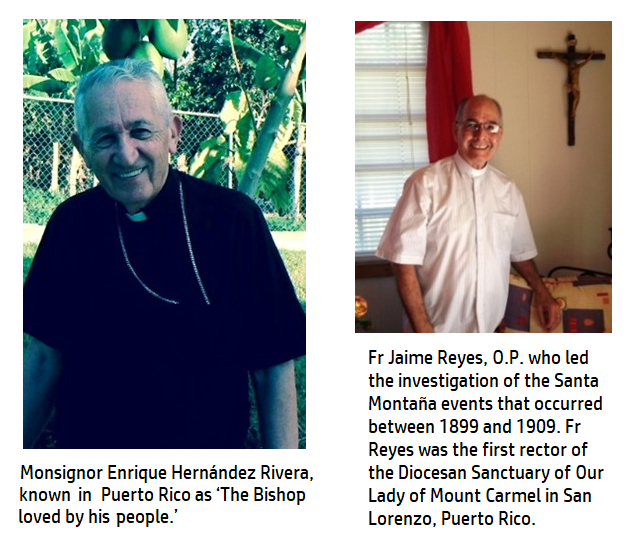
The report
In 1993, the president of the Puerto Rican Episcopal Conference, Monsignor Fremiot Torres Oliver, ordered an investigation into the events of Santa Montaña. In charge of the investigation was Father José Dimas Soberal, Vicar General of the Diocese of Arecibo.
In his final report, posted on August 15, 1994, Father Soberal, among other things, concluded that:
- [Note that without counting on or presenting any evidence:] the person that lived in La Santa Montaña with Puerto Rican peasants between 1899 and 1909 was not the Virgin Mary, but a Dutch citizen named Elena Huyke;
- [Note that without any medical examination:] these peasants (the witnesses), because they were mostly illiterate and poor, as well as being senile, created a myth that their descendants repeated;
- [Note that without taking into account the apparitions in Tepeyac, Lourdes and Fatima, among others,] the person that was in La Santa Montaña between 1899 and 1909 could not be the Virgin Mary because after her Assumption the latter had not returned to tread the Earth and;
- To say that the Virgin Mary had been the figure that was in La Santa Montaña between 1899 and 1909 was to believe in reincarnation.
Monsignor Hernández Rivera and Fr Reyes disagreed with the report issued by Fr Soberal. The report was sent to all the bishops of Puerto Rico but the response by Monsignor Hernández Rivera and Fr Reyes did not go beyond Monsignor Torres Oliver’s desk. Due to great pressures, in 1998 Monsignor Hernández Rivera presented his resignation as bishop of the Diocese of Caguas.
About seven years later (2005), while a Puerto Rican journalist was researching to write a book about Santa Montaña, she contacted the Diocese of Caguas to inquire about the opinion of the bishop on the identity of Our Mother. She was informed by an officer of the diocese, that Monsignor Rubén González had no comments on the matter because the diocesan investigation into those events was closed. The journalist asked who was the officer who had ordered the closure of the investigation. The response was: “I do not have that information.”
The information researched by the journalist for that book includes the memoirs of Adolfo Ruiz Medina, dictated by him before dying. In them, the former lumberjack recalls his ten years as a disciple of Our Mother in Santa Montaña.
In a second book written by the same journalist, she included the official certificates of birth and death of the citizen Elena Huyke, which were obtained by the Dutch genealogist Mathijas Vonder. Those documents and others issued by the Spanish authorities prove that Elena Huyke—the Dutch citizen referred to by Fr Soberal in his report—was born in Curaçao, in the Netherlands Antilles in 1847, arrived in Puerto Rico with her family, lived in the municipality of Arroyo, and appears registered in the Spanish census of 1870. She then returned to Curaçao with her father in 1880 and died there in 1925. In conclusion, that Elena Huyke left Puerto Rico 19 years before Our Mother arrived at La Santa Montaña and died outside Puerto Rico 16 years after the burial of Our Mother.
The blood
During the decades that followed the passing of Our Mother, her disciples and their descendants kept the place where Mother had lived with the Puerto Rican jibaritos, marking and protecting the place where her humble little house stood, and where she shed her blood. They also built a rustic chapel that was used as a place of prayer by the pilgrims visiting the area.
In 1935, Félix Rodríguez Tirado—a resident of Patillas who testified that Our Mother had told him that God had sent her to talk about salvation to all—was digging in the area where Our Mother spilled her blood. He planned to place a monument there. Then he found some pieces of cloth with the blood of Our Mother. He was so strongly impressed by the fact that the blood was still fresh—25 years after the burial—that he pulled them out quickly and buried them again in a nearby place about three or four feet deep.
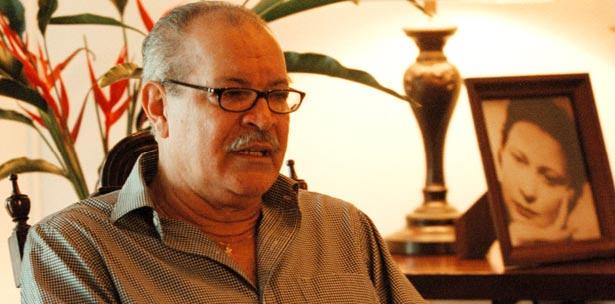
In 2013, Gerardo González Rosario, a resident artisan from the San Salvador, neighborhood of Caguas, and grandson of the disciple Alberto Rosario Galarza—who was part of the group known as Soldiers of Our Mother—signed an affidavit before a lawyer attached to the Commission of Civil Rights of Puerto Rico, Joel Ayala Martínez. In the document he indicated that in 1984 he had received orders from Our Mother to go to Santa Montaña, which he did. Following her precise instructions, he found the jars containing the blood spilled in 1909 that were buried back in 1935. To his surprise, he discovered that the blood was still fresh. After removing the bottles—while preparing to bury them again where instructed—he asked permission to take a piece of blood-stained cloth for himself. With permission granted by Our Mother, he placed them in a small glass jar that he closed with a cork and carried away his pocket.
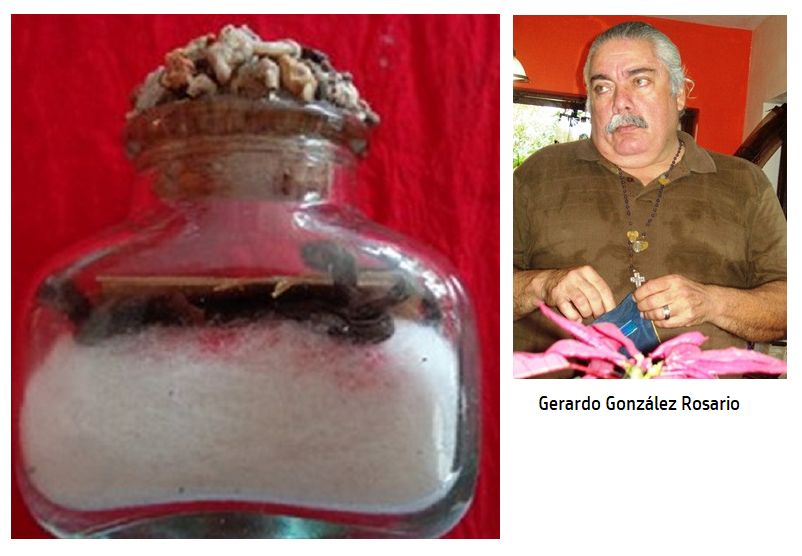
González Rosario did not reveal to anyone what happened until he again received instructions from Our Mother in 2013, this time ordering him to show the blood sample he had kept hidden since 1984.
On January 9, 2013, David Ortiz Angleró, actor, speaker and former president of the Association of Producers and Artists of Shows—known by its acronym, APATE— visited the residence of Mr. González Rosario in the San Salvador neighborhood of Caguas. Angleró, had in front of him and in full view—from 9:45 a.m. until noon—the transparent glass bottle containing the blood of Our Mother. By affidavit signed on March 2, 2013 before Commissioner Joel Ayala Martínez, Agleró indicated that the blood still remained liquid, and had the color of red apples. In addition, from the glass container—although it was closed—emanated a strong scent of roses. The statement of Mr. Angleró was officially certified in accordance with the laws of Puerto Rico.
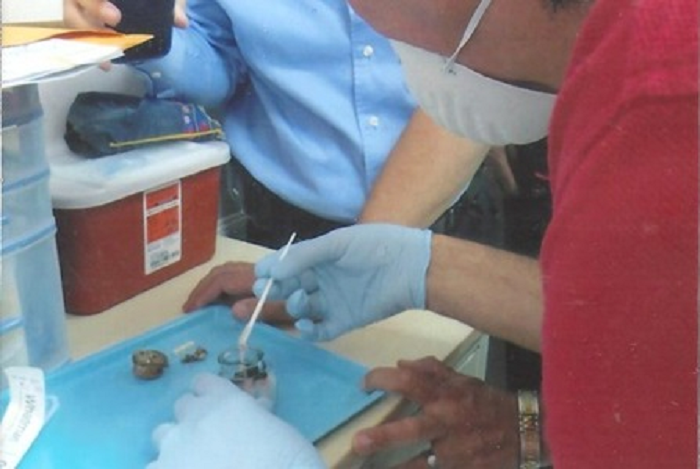
On February 12, 2013, a sample of the blood was extracted under strict aseptic conditions to prevent contamination. The blood—still in a liquid state: fresh—was taken to the Advanced DNA Identification Center to perform a mitochondrial study, remaining all the time under the supervision of González Rosario. The study of the sample was carried out by the owner of said laboratory, Dr. Gilberto Aponte Machín, in the presence of twelve witnesses of various professions and trades, all of impeccable reputation. All of that was duly recorded according to law.
The witnesses observed the moment when the bottle was opened, as well as the strong, identifiable and penetrating fragrance of roses that lasted until it was closed. They also attested to the immutability of the blood, which remained in a liquid state and of a bright scarlet red color during the 27 minutes that the extraction of the sample lasted. Six of the witnesses photographed the procedure with digital cameras. Two of them took videos of the examination room while the procedure was in progress.
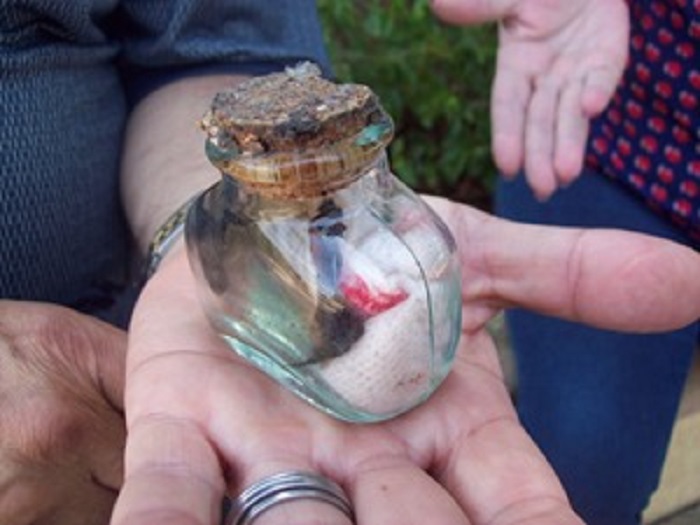
The scientists attempted to determine (1) if the liquid substance in the glass container was actually human blood, (2) the sex of the person to whom it belonged, and (3) the ancestry of the subject through DNA analysis.
The officially certified result of the analysis, dated February 28, 2013, indicates—beyond any doubt—that the blood extracted from the bottle under the custody of Mr. González Rosario comes from a woman and that the associated probability of that person being Puerto Rican is 1 in 577 million trillion. By way of reference: the estimated population of the Earth is around 7.1 billion people, or 7,100,000,000 human beings.

A Puerto Rican expert, on condition of anonymity, who works in a genetic research laboratory in San Juan, holding a master’s degree in biology with a concentration in phylogenetics—the science of classifying species—translated the scientific nomenclature in the document to a language understandable to the average citizen, indicating the peoples whose genes appear in the blood.
The list below has two columns. To the left are listed the genetic markers (numbers and letters) that appear in the result issued by Advanced DNA Identification Center, Inc. and on the right are the peoples identified with those genetic markers. The names of the towns, countries and continents mentioned in the list appear in the same order of the list.
DNA RESULTS [COMPATIBILITY MODE] — GENETIC MARKER COMPATIBILITY
| D3S1358(3p) | Philippines |
| THO1 (11P15.5) | S. Africa, Timor Leste (South East Asia) |
| D21S11 (21q11-21q21) | Apache, Argon (India) |
| D18S51 (18q21.3) | Native American, Egyptian |
| D5S818 (5Q23.3-32) | Hutu (Rwanda) Arab (Tunisia) |
| D13S317(13q22-q31) | African (Colombia,) Guinean |
| D7S820 (7q11.21-22) | Baiti (India) Hungarian, Romany |
| D16S539 (16q2.4-qter) | Inupiat (No. Alaska) Japan |
| CSF1PO (5q33.3-34) | Lai (India) |
| PENTA D (21q) | Baniya (India) Malay (Singapore) |
| VWA (12p12-pter) | Byelorussian (Poland) Bubi (Eq. Guinea) |
| D8S1179 (8q) | Eq. Guinean (Spain) Athabaska (Alaska) |
| TPOX (2p23-2pter) | Berber (Tunisia) Lithuanian |
| FGA (4q28) | Mestizo, Bniya (India) |
| Amelogenin (Xp22.1-22.3) | N/A |
Note: Tribes were located through the Earth, Human and Short Tandem Repeat Allele Frequencies Database (EHSTRAFD). The tribes were located through the database Frequencies of the Tandem Repetition of Human Earth Alleles. Highlighting in red indicates the highest frequency.
The information provided by this expert was examined by Dr Miguel de Puigdorfila, who holds a master’s degree in biological studies. He is also a lawyer, historian and a prominent philologist with extensive knowledge of forensics, and is a scholar in the field of human migration history.
The explanation offered by Dr Puigdorfila after examining the expert’s document indicates:
Although the results of the analysis of the blood of Our Mother contains genes from ancient peoples that spread throughout the world, our problem now is: that we would be speculating, if we were to guess why the blood of Our Mother contains genes from people from all over the world. Due to the destruction of the libraries of the great ancient civilizations, the information regarding ancient migratory trends is mostly based on theories, and it is sometimes contradictory. We lack reliable records of the world’s migratory currents beyond the year 1,000 B.C.
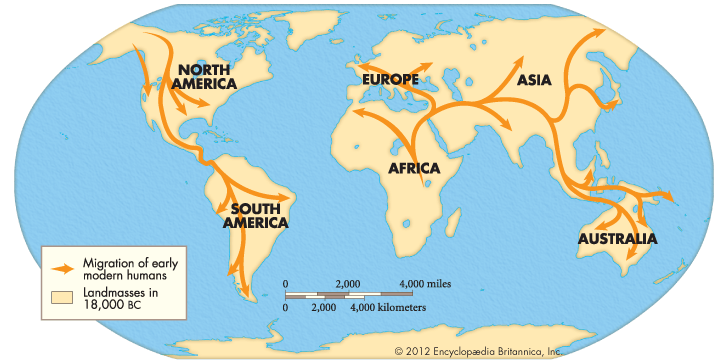
In this professional statement, Dr Puigdorfila reveals his scientific and personal surprise at finding the near impossibility that the woman whose blood was analyzed was a Puerto Rican.
The official publication (1980 edition) of UNESCO indicates that the population of Puerto Rico was composed of 89% of whites from all European ethnic groups but especially Spanish, French, Italian and Irish, and that their descendants had mixed with Taino Indians, and with 11% African blacks and mulatto. We are forced to consider that the current Puerto Rican population descends from successive emigration waves of European whites that occurred during the last 500 years. The most obvious, the Spanish, but not necessarily the majority in the 19th century, because: (1) the Spanish are a mixture of the following peoples: Tartessian, Phoenician, Carthaginian, Iberian, Greek, Roman, Visigoth, Alano, Swede, Astur, Egyptian, Basque, French, Arabic, Assyrian, Palestinian, Bedouin, Black and Berber, to name a few besides the Romans; (2) the French are a mixture of Gauls, Romans, Arabs, Gascon, Franks, Saxons, Goths and Corsican; (3) the Italians are a mixture of Romans, Etruscan, Lombard, Greek, Sicilian, Sardinian and Neapolitan. Blacks are a mixture of Igbo, Mandingo and Bantu. To all this we must add the Russians, Irish Celts, Poles, Scandinavians, Danish and Dutch mixtures that make up the American people, whom also arrived later. If the blood of the woman who was analyzed does not contain genes identified with any of the components mentioned, that would imply that she does not descend from that mixture of races. And if we consider that this mixture of races is the identifiable rule for the Western European targets of the last 1,500 to 1,000 years, that would mean that the subject comes from a different, more ancient ethnic mix. [NOTE: compare with Proverbs 8:22-36]
In March 2013, Mr. González Rosario sent a letter to Monsignor Rubén González, bishop of the Diocese of Caguas, as well as to the remaining five bishops of Puerto Rico—San Juan, Ponce, Mayagüez, Arecibo and Fajardo-Humacao—informing them about the relic in his custody, how it was found, the DNA test performed on it, the reading of the blood test, and the comments of experts on the matter. Shortly after, a press conference was held in San Juan to pass that information to the Puerto Rican people.
The bishop of the Diocese of Caguas, Monsignor Rubén González, sent a letter to Mr González Rosario, indicating that he had ordered the creation of an ad hoc committee composed of four priests to study the recent revelations made by Mr González Rosario. The same González Rosario was interviewed on November 5, 2013 by that committee, which consisted of a psychiatrist, a psychologist, a Mariologist, and a geriatric expert. The interview, which took place in the Diocesan See of Caguas, lasted three hours. So far—as this is written in the summer of 2015—the committee has not interviewed any other person, including Father Reyes.
Monsignor Gonzalez ceased in his duties as Bishop of the Diocese of Caguas in January 2016 and, until the time of his departure, he made no pronouncement about the evidence that was sent to him. The scientific commission appointed by him has not issued any public statement on that matter either.
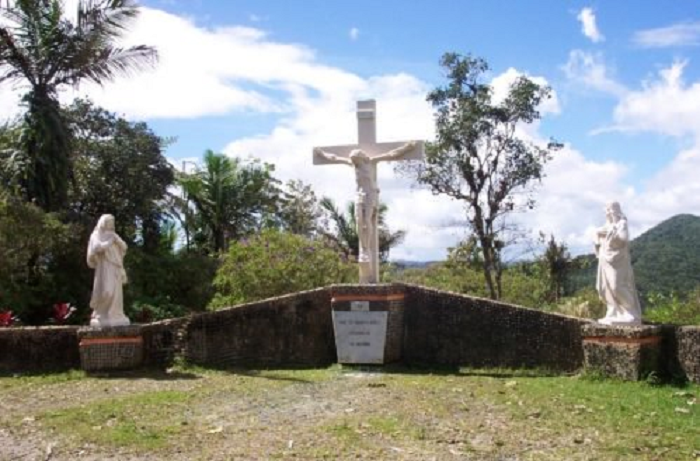
The Prophecies
This list of prophecies was taken from the book by Fr. Jaime Reyes. O.P. La Santa Montaña de San Lorenzo, Puerto Rico y el Misterio de Elenita de Jesús 1899-1909
1. When those who climbed the Mountain do not put oil in the lamp— the one I left below by one of the gates—the Mountain will be darkened.
2. My work will be forgotten, but little ones will start it again and great ones will finish it with great splendor.
3. The Mountain will fall, but it will rise again with more strength.
4. When I am gone the Mountain will go back into darkness, but eventually people will climb up the Mountain like ants.
5. When I leave, the Mountain will fall, but eventually it will blossom like a rose.
6. The Mountain will shine again with a holy man at the Santa Peña (Holy Rock).
7. When I am gone, men will come who will continue my mission.
8. A road will pass through the Mountain.
9. Those who are in trouble, climb the Mountain, that will be salvation for many.
10. Water will be scarce, but the Spring of the Mountain will always have its balm. When water dries up in other places, there would be no lack of it in the Mountain.
11. The Mountain will have a village and people will come from everywhere to the Little Town of Dawn.
12. Many pilgrims will climb here in 70 to 80 years.
13. If Puerto Rico were to sink, the Mountain will not sink.
14. The Mountain is in front of Jerusalem, where God shed His Blood. [NOTE: The spot where Elenita asked the jibaritos to build her hut is at an elevation (2,226 ft) slightly below Mt Calvary (2536 ft)]
15. At the end of time the Mountain will be dressed in blue. Some will try to reach it but they won’t be able.
16. At the end of time the crows will return to the mountain.
17. The Mountain is the place where the living and the dead are judged.
18. When Abdón del Valle brought a letter from Elenita to the Bishop of Puerto Rico, the prelate responded negatively and Elenita said that she would see the Bishop and the priests go up the mountain without being called; that those who heard her did not see who she was.
19. The priests will not believe in me, but I await them on the mountain.
20. When the Bishop will go up the Mountain, it will be already the end of time, or the world would have little time left.
21. Priests will sleep on the Mountain.
22. In the end of times, the Pope will come to the Mountain.
23. I will appear as a white dove in the Mountain and in the house of my people.
24. I will travel and I won’t be buried until three days have passed.
25. I will come to take those who are mine.
26. I will always be in the mountain: Some will not see me but they will feel my presence.
27. I will return to the Mountain for the End of the World.
28. The Virgin of Dawn will come to the mountain.
29. The Little Town of Dawn (el Pueblecito de la Aurora) will grow here.
30. The Little Town of Dawn will come in about 80 years.
31. The Little Town will be as far from the Great Day as the mouth is from the nose.
32. There will be few priests.
33. Churches will be closed but you must pray at their doors.
34. False prophets will come that will want to conquer the Catholic religion.
35. Time will come when you will place the Three Divine Persons on the door.
36. In the End Times, her portrait will come to the Mountain, the end will be near.
37. A good government will come but others will not be like it.
38. Women will vote in elections.
39. A political party will raise that will be very difficult to defeat.
40. A political party will raise that will corrupt Puerto Rico.
41. Puerto Rico will be Communist for 48 hours and many will suffer.
42. Country will be town and town will be country. Where thorns grow the land will be cleared and where the land is clear thorns will grow.
43. There will be green leafy land without fruit.
44. No one will want to work the land.
45. Women will take the jobs from men.
46. Puerto Rico will have many highways.
47. There will be businesses one on top of another.
48. There will be plenty of food.
49. Money will come to your homes, bless it and use it.
50. There will come a time when there will be no need to use money.
51. Men will flee from women.
52. There more light there is, the darker it will be.
53. The valleys of Puerto Rico, will be pasture for fish.
54. Sea waters will flood Yabucoa.
55. Arroyo and Guayama will burn.
56. Men will walk up in the air.
57. Men will travel in carts without oxen and on headless horses.
58. When men talk to each other without seeing each other, the end will be near.
59. There will be too much clothing.
60. Hospitals will be so full, that they will give poison to patients as medicine.
61. There will be houses made of iron.
62. The 20th century will be the century of light.
63. There will be no respect.
64. There will be neither parents for children nor children for parents.
65. There will be a war in which they will toss children to make them fall on bayonets.
66. Parents will kill their children.
67. Families will be unknown.
68. Women will chase after men.
69. Women will dress like men.
70. Women will walk around naked.
71. Men will die like animals.
72. Blessed those who have their mind by 60, many who live longer won’t have it.
73. Governments will not agree with each other.
74. There will be universal war.
75. I will appear at the end of times but even so the priests will not believe.
76. The last stage of the world. Communism will govern many countries.
77. When you see people moving like ants not settling anywhere, be prepared because the arrival of Christ is near.
78. When the sea roars three times and a Cross appears, that is the end of the end times.
79. The last sign before the end is a Cross that will appear in the sky.
80. Three days before the Judgment, water will be denied; it will be heard but not seen.
81. Sunday and Christmas Eve will be the end of times. Remain in prayer
By Vionette G. Negretti

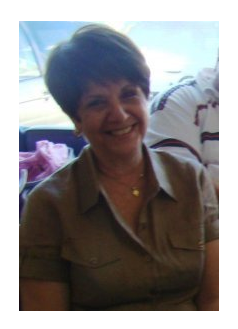 Translated by Carlos Caso-Rosendi. Extracted from La Buenaventura, and the article Historia de Nuestra Madre by Vionette G. Negretti (photo). Warning: some long descriptions of legal documents and certifications were omitted since they are not material to the alleged apparitions. The complete original document in Spanish is published HERE. The list of prophecies is not part of the original article by Vionette G. Negretti. It was taken from the book La Santa Montaña de San Lorenzo, Puerto Rico y el Misterio de Elenita de Jesús 1899-1909, by Fr. Jaime Reyes. O.P. I have highlighted in red those prophecies that caught my interest.
Translated by Carlos Caso-Rosendi. Extracted from La Buenaventura, and the article Historia de Nuestra Madre by Vionette G. Negretti (photo). Warning: some long descriptions of legal documents and certifications were omitted since they are not material to the alleged apparitions. The complete original document in Spanish is published HERE. The list of prophecies is not part of the original article by Vionette G. Negretti. It was taken from the book La Santa Montaña de San Lorenzo, Puerto Rico y el Misterio de Elenita de Jesús 1899-1909, by Fr. Jaime Reyes. O.P. I have highlighted in red those prophecies that caught my interest.
A coincidence with that strange and controversial vision attributed to George Washington that circulates since the 1860’s
The Azure Standard
“Mother requested that an image of Our Lady of Mount Carmel was placed on the porch of the house. Along with it she placed a flag, a blue cloth with flaming golden stars, very similar in color and ornaments to the mantle of Our Lady of Guadalupe.”
from: Our Lady of Mount Carmel in Puerto Rico
Then once more I beheld the villages, towns and cities springing up where I had seen them before, while the bright angel, planting the azure standard he had brought in the midst of them, cried with a loud voice: “While the stars remain, and the heavens send down dew upon the earth, so long shall the Union last.” And taking from his brow the crown on which blazoned the word “Union,” he placed it upon the Standard while the people, kneeling down, said, “Amen.”
from: A vision attributed to George Washington
LikeLike